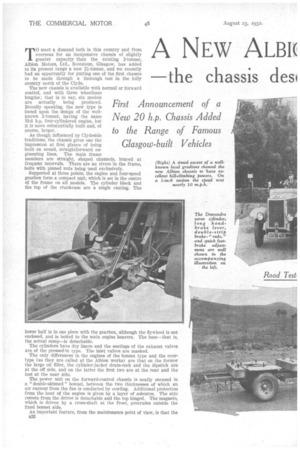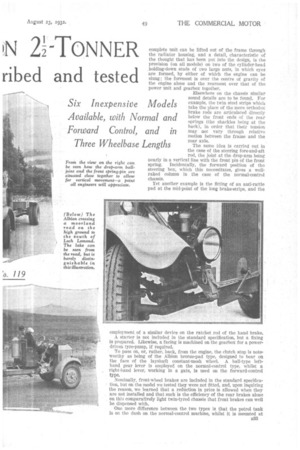A NEW ALBI(
Page 50

Page 51

Page 52

Page 53

If you've noticed an error in this article please click here to report it so we can fix it.
N NNER the chassis des1 ribed and tested
T0 meet a demand both in this country and from overseas for an inexpensive chassis of slightly greater capacity than the existing 2-tonner, Albion Motors, Ltd., Scotstoun, Glasgow, has added to its present range a new 2i-tonner, and we recently had an opportunity for putting one of the first chassis to be made through a thorough test in the hilly country north of the Clyde.
The new chassis is available with normal or forward control, and with three wheelbase lengths; that is to say, six models are actually being produced. Broadly speaking, the new type is based upon the design of the wellknown 2-tonner, having the same 19.0 h.p. four-cylindered engine, but it is more substantially built and, of course, larger.
As though influenced by Clydeside traditions, the chassis gives one the impression at first glance of being built on sound, straightforward engineering lines. The main frame members are straight, shaped channels, braced at frequent intervals. There are no rivets in the frame, bolts with pinned nuts being used exclusively.
Supported at three points, the engine and four-speed gearbox form a compact unit, which is set in the centre of the frame on all models. Tlie cylinder block and the top of the crankcase are a single casting. The lower half is in one piece with the gearbox, although the flywheel is not enclosed, and is bolted to the main engine bearers. The base—that is, the actual sump—is detachable.
The cylinders have dry liners • and the seatings of the exhaust valves are of the pressed-in type. The inlet valves are masked.
The only differences in the engines of the bonnet type and the overtype (as they are called at the Albion works) are that on the fornier the large oil filler, the cylinder-jacket drain-cock and the dipstick are at the off side, and on the latter the first two are at the rear and the last at the near side.
The power unit on the forward-control chassis is neatly encased in " double-skinned " bonnet, between the two thicknesses of which an air current from the fan is conducted by cowling. Additional protection from the heat of the engine is given by a layer of asbestos. The side remote from the driver is detachable and the top hinged. The magneto, which is driven by a cross-shaft at the front, protrudes outside the fixed bonnet side.
An important feature, from the maintenance point of view, is that the B32 complete unit can be lifted out of the frame through the radiator housing, and a detail, characteristic of the thought that has been put into the design, is the provision (on all models) on two of the cylinder-head holding-down studs of two large nuts, in which eyes are formed, by either of which the engine can be slung; the foremost is over the centre of gravity of the engine alone and the rearmost over that of the power unit and gearbox together.
Elsewhere on the chassis similar sound details are to be found. For example, the twin steel strip S which take the place of the more orthodox brake rods are articulated directly below the front ends of the rear springs (the shackles being at the back), in order that their tension may not vary through relative motion between the frame and the Tear axle.
The same idea is carried out in the case of the steering fore-and-aft rod, the joint at the drop-arm being nearly in a vertical line with the front pin of the front spring. Incidentally, the forward position of the steering box, which this necessitates, gives a wellraked column in the case of the normal-control chassis.
Yet another example is the fitting of an anti-rattle pad at the mid-point of the long brake-strips, and the
employment of a similar device on the ratchet rod of the hand brake. A starter is not included in the standard specification, but a fixing is prepared. Likewise, a facing is machined on the gearbox for a powerdriven tyre-pump, if required.
To pass on, or, rather, back, from the engine, the clutch stop is noteworthy as being of the Albion bronze-pad type, designed to bear on the face of the layshaft constant-mesh wheel. A ball-type lefthand gear lever is employed on the normal-control type, whilst a , right-hand lever, working in a gate, is used on the forward-control type.
Nominally, front-wheel brakes are included in the standard specifica ' tion, but on the model we tested they were not fitted, and, upon inquiring the reason, we learned that a reduction in price is allowed when they are not installed and that such is the efficiency of the rear brakes alone on this comparatively light twin-tyred chassis that front brakes can well be dispensed with.
One more difference between the two types is that the petrol tank Is on the dash on the normal-control machine, whilst it is mounted at B33
frame level on the near side—the feed being by Autovac—on the forward-control chassis.
All moving parts of the chassis, such as shackles, cardan-shaft bearing, brakegear bearings,. and so forth, are lubricated by the Tecalemit oil-gun system, the majority of the nipples being grouped together in accessibly placed batteries ; each nipple is labelled.
Heavy-duty reinforced 32-in. by 6-in. tyres, on the single front and twin rear wheels, are fitted as standard.
The type numbers, wheelbases and prices are as follow :—Normal-control type, LE46, 12 ft., £475; LEB46, 14 ft., £485; Special LE46, 10 ft. 9 ins., £475. Forward-control type, LE47, 10 ft. 0 ins., £475; LEA47, 12 ft., £485; LEB47, 14 ft., £495. The short-wheelbase normal-control chassis is intended for a tipping or special body.
The chassis showed up well on test, somewhat better, in fact, than the accompanying acceleration graph denotes, for the figures from which the graph was drawn were obtained early in the day with the engine hardly warmed up and with the total mileage of the vehicle standing at cnly 156. After a hard run of some 70 miles a marked improvement was noted as regards both maximum speed and liveliness. Furthermore, it is by no means easy in the Glasgow district to find a road which is straight and level for a sufficient distance and not too frequented for adequate acceleration tests to be made. • Circumstances prevented 35 m.p.h. frombeing exceeded during the test and greater speeds wauld hardly be demanded or expected of this chassis in the hands of the average user, but, returning at the end of the day from Balloch to Glasgow, a distance of about 18 miles was covered in little over the half hour, and the sPeedoineter needle was at the 40 mark on several occasions.
Gardner Street, Glasgow, which has a maximum gradient of 1 in 5. was ascended at a steady 5 m.p.h. in first gear, and this in 'spite of slight misfiring caused by an air lock (subsequently remedied) in the temporary petrol system. On the steepest portion of the hill we stopped the machine, satisfied ourselves that each brake alone was well capable of holding the fully laden chassis, and with supreme ease restarted.
Our consumption test was made from Scotstoun to Strathblaue and back, the distance being 20.1 miles. The road first ascends steadily to an altitude in the neighbourhood of 500 ft. above sea level and then drops steeply ; we bad, therefore, considerable third-gear and occasional second-gear work to do, both on outward and return journeys, but we indulged in no coasting. Under such conditions a consumption of 1 17-32 gallon (13.1 m.p.g,) at an average speed of exactly 20 m.p.h. is certainly creditable. The jet and choke sizes were :—Main, 100; compensator, ; ventuni, 21. .
Cuilt Brae is a local eminence, the zigzag road up which has a fairly consistent gradient for six-tenths of a mile, which includes a measured quarter-mile' of 1 in 8. Approaching the bill at moderate speed, a change to third was made, and, one-tenth of a mile later, to second ; our. speed was then 10 m.p.h., which dropped to 8 m.p.h. and rose again to 12 m.p.h. as the summit was passed.
The measured quarter-mile was traversed in 1 niinute 35 seconds (9.48 m.p.h.). With the atmosphere at 65 degrees . F., the climb raised the temperature of the cooling water (measured at the filling orifice) from 140 degrees F., to 178 degrees F., these readings being taken at the foot and summit of the hill respectively.
The following is a brief summary of our general impressions of the behaviour, of the machine. The road-holding was excellent. This was well demonstrated by the Albion test driver, for no skidding, swaying, or disconcerting behaviour of any description could be provoked on wet tar, tone setts or loose surfaces by normal or reasonably abnormal driving methods.
The temporary seat rigged up on the chassis was not too conveniently situated. for the gear lever, and we cannot truthfully say that, when handling the chassis ourselves, we made perfect changes every time. However, we succeeded in accomplishing a sufficient number of snappy changes to feel convinced that a better driving position and the acquisition of a little more knack would make no complaint of the gear-change justifiable. Brakes, hand and foot, clutch and accelerator, are well placed and operable without excessive exertion.
. The silencing system struck us as being rather small for its job and the exhaust a trifle noisy in consequence, but the peppiness of the power unit is, perhaps, the real offender in this respect. With a liking for high r.p.m., the engine, nevertheless, hung




































































































